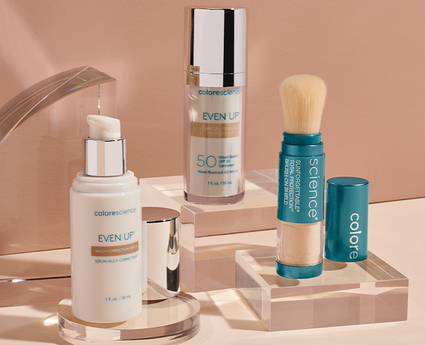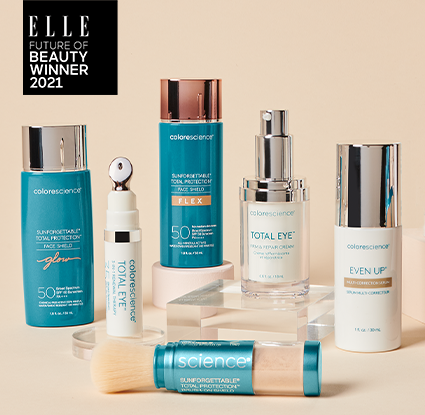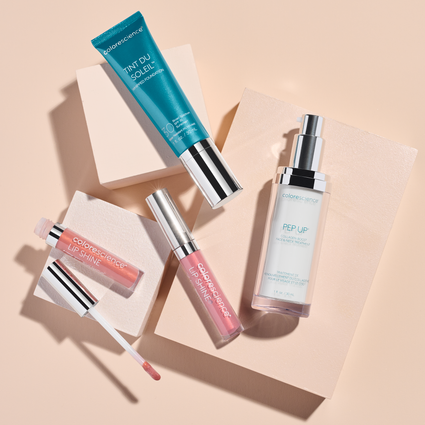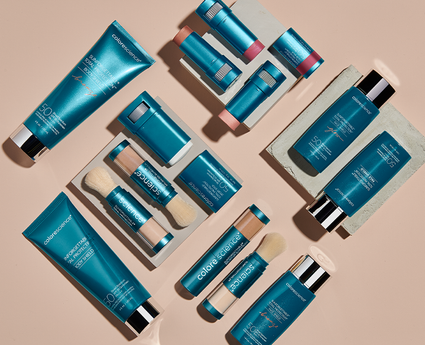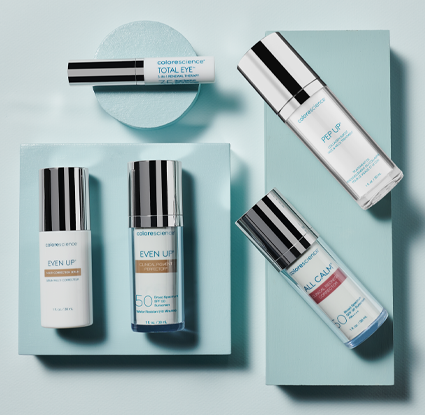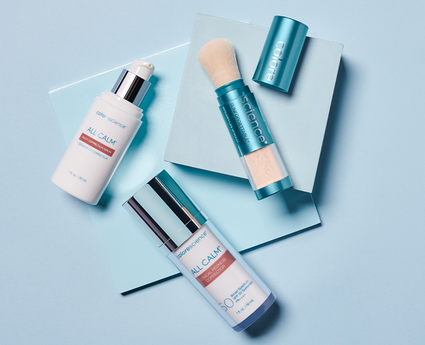Sunblock vs. Sunscreen: What’s the Difference?
Have you ever wondered what the difference between sunblock vs. sunscreen is? Very often, people refer to sunblock as sunscreen, and vice versa. While most people call them both variations of the term, traditionally, in the industry, there is a technical difference in how these words are used. The main difference is how products referred to as sunblock vs. sunscreen protect the skin.
There are many types of sunscreen on the market. Tinted sunscreen is very popular and used in makeup, face sunscreen, and body sunscreen. Each one has a specific purpose, but you can use body sunscreen on the face depending on your skin type. There are pros and cons to each one.
Mineral sun protection
Pros: they are effective from the time of application and won’t clog pores. They also offer full protection from the sun’s UVB and UVA rays.
Cons: they may leave a white cast on the skin, but new formulations have improved. Specifically, with Colorescience, you don’t have to worry about this!
Chemical sun protection
Pros: typically more widely available, as mineral sunscreens are a more recent innovation.
Cons: allows some UVA rays to get through, and you must wait at least 20-30 minutes after application to go out in the sun.

Sunscreen vs. Sunblock: Three Differences
While many people use the terms sunscreen vs. sunblock interchangeably, there are technical differences that may apply in regards to the traditional industry used term:
Sunscreen
- Sunscreen filters UV rays from the sun, but in some cases, they still get in and affect the skin. Sunscreen is also known as a chemical sunscreen.
- The application is different. You must give your skin at least 30 minutes to absorb.
Sunblock
- Sunblock reflects the sun’s rays away and doesn’t penetrate the skin. This is also known as a physical sunblock (or sunscreen). In most cases, sunblock contains titanium oxide while sunscreen contains oxybenzone or avobenzone. These make the sunscreen vs. sunblock difference notable.
- Sunblock is also known to be thicker than sunscreen, with the exception of mineral sunscreens. As such, traditional sunblock can be hard to rub in.
Now, the FDA has changed verbiage in terms of using the word sunblock. In fact, manufacturers can no longer use the word sunblock.
That means that companies who aren’t using zinc oxide and titanium oxide may label their products as lightweight sunscreen because it is not considered to be as effective. There are, however, products on the market labeled as lightweight sunscreen using natural ingredients that are very effective.
We know it’s a bit confusing, but we’ll help clear it up.

Sunscreen vs. Sunblock vs. SPF
According to the FDA, SPF (sun protection factor) is a measure of how much solar energy (UV radiation) is required to produce sunburn on protected skin relative to the amount of solar energy required to produce sunburn on unprotected skin.
SPF is the sun protection factor found in sunscreen and sunblock. There are ratings attached to the concentration and how much of the sun’s UVB rays. At the minimum, an SPF of 30 is recommended by the American Academy of Dermatology. The amount of protection with higher SPF numbers increases, but one should not expect an SPF to block 100% of the rays. SPF is another ingredient found in sunscreen and sunblock and is not a standalone product.
Sunblock vs. Sunscreen: Which is Better?
In most cases, sunblock is considered to be more effective because it has zinc oxide and titanium dioxide. These are the ingredients that meet the FDA’s requirements to be labeled as safe and effective. These ingredients, when comparing sunscreen vs. sunblock, are thought to be better for the overall environment and work to protect the skin.
With the change in regulation concerning the use of the word sunblock, the sunblock vs. sunscreen debate lies within the ingredients. Generally, you want to look for sun protection with mineral or natural ingredients instead of chemicals that can be harmful. You should always read the ingredients of any sunscreen on the market to determine if its properties mirror that of sunblock or true sunscreen.

Checking the ingredients will help you find a product that offers sufficient protection for the skin. Typically, you want SPF 30 or higher.
What Makes for the Best Sun Protection?
Mineral sunscreens offer the best protection because of their ingredients. A big sunscreen myth is not having zinc oxide or titanium dioxide in the formula and getting the best protection from the sun. Mineral sunscreens are safer, especially for people who have very sensitive skin, children, and those who have skin diseases.
Mineral sunscreens help fight against sun damage, skin cancer, and signs of premature aging from exposure to the sun. Broad-spectrum, mineral sunscreens also provide the most protection against the full spectrum of radiation from UV rays. And, when it comes down to skin irritation, mineral sunscreens are top-notch in this area because the ingredients aren’t absorbed into the skin but sit on the surface.
Chemical sunscreens can cause different skin reactions from exposure to the skin, especially if exposed to the skin for long periods of time without reapplication. With mineral sunscreen, there is also no wait time after application. You can go into the sun immediately after applying it instead of having to sit and wait for the sunscreen to start working.

For women looking for a good sunscreen to wear under makeup, mineral-based sunscreen is very effective. There are numerous formulations on the market that have mineral sunscreen in the makeup or compacts with mineral protection in them. While many people are concerned about how thick mineral sunscreen is, this is a myth.
New formulas have changed mineral sunscreen into clear applications that don’t have a white film. For those who have acne, mineral sunscreens can help in keeping outbreaks from the sun at bay. The sunscreen doesn’t absorb into the skin or pores.
When making any decision regarding sunscreen, there are a few things to consider:
- The ingredients: Remember, zinc oxide and titanium dioxide are what you want to look for.
- Type of application: This is up to your preferences—you can select a powder, lotion, or stick application.
- Replication: Sunscreen isn’t effective if it’s not applied correctly and reapplied frequently. Take the time to apply a solid layer to protect your skin under any conditions involving the sun. Keep an eye on the time and make sure to reapply every 80 minutes or so. If you’re going to be swimming or sweating, look for a water-resistant sunscreen and reapply every 40 minutes or so.
- Do not forego using sunscreen: There are many people who don’t use sunscreen because they don’t understand how harmful the sun’s rays are. Make sure you use sunscreen every time you plan on going outdoors into the sun to make sure you protect your skin.
Mineral Sunscreen Provides Unparalleled Protection
When considering sun protection, mineral sunscreen is an excellent option because it uses zinc oxide and titanium dioxide, which are two natural ingredients that sit on top of your skin to effectively reflect UV rays. Mineral sunscreens are FDA-approved and reef-safe to provide protection even when swimming.
Colorscience’s Sunforgettable Total Protection brush-on sunscreen is the only powder sunscreen recommended by the Skin Cancer Foundation for active use. It provides complete protection in a convenient, on-the-go application.
Another Colorscience product, the Sunforgettable Total Protection Face Shield Flex SPF 50 has tinted color coverage for a smooth, even complexion. Having SPF in makeup helps provide the best defense against UVA/UVB, blue light, pollution, and infrared radiation. This mineral-based product nourishes and hydrates for flawless skin.
The Sunforgettable Total Protection Sport Stick SPF 50 is a broad-spectrum sunscreen with family-friendly ingredients that hydrate the skin while offering protection from environmental aggressors.
While traditional sunblock is known to have zinc oxide, Colorscience’s sunscreen has zinc oxide in its ingredients which makes it just as powerful as sunblocks on the market.
Protect Your Skin with Confidence
One of the most important things to remember when considering sunscreen vs. sunblock differences and looking for effective sunscreen is that you must read the ingredients in the sunscreen before deciding on whether it is a good fit for you and your skin.
Your skin is important, and the products you use on your skin make a difference. For the best sunscreen protection, use mineral sunscreen that does not absorb into the skin but reflects harmful rays away from your body. Colorscience has an array of sunscreen products that are made with safe, natural ingredients and offer versatility so you can find a solution that’s just right for you. Shop our sunscreens today to make sure you’re protected.

